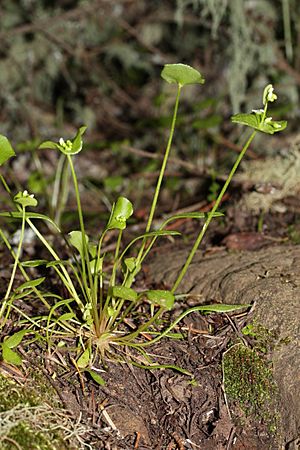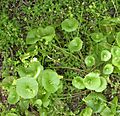Miner's lettuce facts for kids
Quick facts for kids Miner's lettuce |
|
|---|---|
 |
|
| Claytonia perfoliata subsp. perfoliata growing wild in Washington Park, Anacortes, Washington | |
| Scientific classification | |
| Genus: |
Claytonia
|
| Species: |
perfoliata
|
| Synonyms | |
|
|
Claytonia perfoliata is a small, edible flowering plant often called miner's lettuce. It also has other names like Indian lettuce or spring beauty. This plant is known for its fresh, green leaves.
It belongs to the plant family called Montiaceae. Miner's lettuce is a herbaceous plant, meaning it has soft stems, not woody ones. It is also an annual plant, which means it completes its whole life cycle in one year.
This plant grows naturally in western North America. You can find it from Alaska and British Columbia in the north, all the way down to Central America. It is especially common in California's Sacramento and northern San Joaquin Valleys.
C. perfoliata is part of a group of related plants that are very similar. Scientists have studied these plants to understand how they are related and how their populations grow.
Contents
What Miner's Lettuce Looks Like
Miner's lettuce is a soft plant that forms a rosette, which means its leaves grow in a circular pattern close to the ground. It can grow up to about 30 centimeters (12 inches) tall. However, some mature plants can be as small as 1 centimeter (less than half an inch).
When the plant first sprouts, its first leaves are called cotyledons. These are usually bright green, thick, and narrow. The next leaves to grow form a rosette at the base of the plant. These leaves are typically 0.5 to 4 centimeters (0.2 to 1.6 inches) long. They have a long stem-like part called a petiole, which can sometimes be as long as 20 centimeters (8 inches).
Flowers and Stems
The plant produces small pink or white flowers. Each flower has five petals that are about 2 to 6 millimeters (0.08 to 0.24 inches) long. These flowers usually appear from February to June. They grow in clusters of 5 to 40 flowers together.
A unique feature of miner's lettuce is how its flowers grow. They appear above a pair of leaves that are joined together around the stem. This makes them look like a single, circular leaf. Mature plants have many stems that grow upright or spread out from the base.
Where and When It Grows
C. perfoliata is very common in the springtime. It prefers places that are cool and damp. You will often see the plant first in sunny areas after the year's first heavy rains. However, the best patches of miner's lettuce are found in shaded spots, especially in higher areas, lasting into early summer. As the weather gets hotter and drier, the leaves of the plant often change to a deep red color before they dry out completely.
Types of Miner's Lettuce
Scientists have identified three main types, or subspecies, of C. perfoliata based on where they grow:
- Claytonia perfoliata subsp. perfoliata: Found along the Pacific coastal United States and in southwest Canada.
- Claytonia perfoliata subsp. intermontana: Grows in the interior western United States.
- Claytonia perfoliata subsp. mexicana: Found along the coast of southern California and Arizona, extending south to Mexico and Guatemala.
How People Use Miner's Lettuce
The name "miner's lettuce" comes from its use during the California Gold Rush. Miners ate this plant to prevent scurvy, a serious illness caused by a lack of vitamin C.
Eating Miner's Lettuce
Miner's lettuce is in season in April and May. The entire plant, except for the roots, is edible. It is a good source of vitamin C. Most often, people eat it raw in salads. It has a delicate taste, though it's not quite as soft as regular lettuce you buy in stores.
Sometimes, people boil miner's lettuce like spinach. It tastes and has a similar chemical makeup to spinach. However, it's important to be careful. Wild miner's lettuce can sometimes have high amounts of natural substances called oxalates, which are also found in spinach. It's best to eat it in moderation.
Traditional Uses
The Ivilyuat people of Southern California call this plant palsingat or possibly lahchumeek. They traditionally ate it fresh or boiled as a green vegetable. Miner's lettuce, along with another similar plant called Claytonia exigua, is gathered in early spring.
Miner's Lettuce Around the World
Miner's lettuce has also spread widely in western Europe. It was brought there in the 1700s. It is thought that a naturalist named Archibald Menzies brought it to Kew Gardens in London in 1794.
Gallery
Other Names
In the Western Mono language, which is a Native American language from California, Claytonia perfoliata is called piyada̠ʼ. As mentioned earlier, it is called palsingat in Ivilyuat.
See also
 In Spanish: Verdolaga de Cuba para niños
In Spanish: Verdolaga de Cuba para niños





